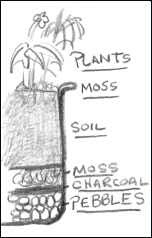 |
| Composting Materials |
For those in homes or dorms feel free to compost also! Though this article is for apartments you can apply the same ideas to your living space. Good compost materials for dorm rooms are half eaten snacks and fruit.
What is Compost?
Compost is a naturally recycled organic waste that is converted into nutrient-rich fertilizer. Although there are many methods of composting, they are all based on the same process: the decomposition of organic matter. Plants and food can decompose quickly at similar speeds. When mixed together and with the of introduction of oxygen over time microbes in the soil will breakdown the waste into an effective fertilizer.
Why Compost?
To be a more environmentally sustainable society we need to reduce, reuse, and recycle our waste. Composting is a way to reduce the amount of organic materials accumulating in landfills. It can also save you the cost of buying potting soil and fertilizer for your Go Green Projects!
The benefits of composting are surprisingly encouraging. The EPA reported Americans spends approximately $1 billion each year disposing of more than 25% of the food we prepare only to be throw away. In 2008, 31 out of the 32 million tons of food waste was put into landfills or incinerators.
Decomposition in a landfill is static without oxygen entering the process and leads to the production of the greenhouse gas methane. Therefore, composing is a method to reduce greenhouse gasses in the atmosphere. It is also a ecological approach to improving soil health, erosion resistance, and off set the need for chemicals in agriculture.
How To: Going Green With Composting
 |
| Composting Bins Tucked Away |
Before starting your composting project decide where you want to place your composting bin. For example, pantries and laundry rooms make good spots.
Next figure out how much food waste you generate and get a bin that won't fill up too fast. Check out a past article, Know Your Space: Green and Sustainable Design, for ideas about usable spaces.
*Learn what can be composted! Placing non-compostable material into your bin can have a negative effect on the decomposition process!
Step 1: Punch holes in the base and sides of your composting bin.
Step 2: Place a tarp or a tray under your compost box.
Step 3: Place a three-inch layer of soil into the box. Also add a handful or two of dry bedding such as, leaves, newspaper, (no colored inks, waxed paper or glossy mags) straw, dry grass clippings, cardboard, nutshells.
Step 4: Shred, pulverize, and cut your compostables as finely as possible to speed process.
Step 5: Add equal parts dry bedding to the compost heap.
Step 6: Stir the compost every week or two.
Step 7: Have another compost bin ready so once your original box begins fill transfer the fine soil-like compost into your second bin.
Some key pointers
-If odor or dripping occurs add more dry bedding.
-Be sure to add a handful of fresh soil every night to refresh microbe supply.
That's it! Visit Sustainable America for a better look at these instructions!
Soon you'll have a compost for all kinds of projects.
Here are some where you can use your compost suggestions: Potted plants, Neighborhood composting projects, Sale as fertilizer on Craigslist, Rooftop gardens
Do you have a project, story, or idea you’d like to share with us? Hit us up on social media or contact Phillip Stringer at info@collegegogreen.org
Do you have a project, story, or idea you’d like to share with us? Hit us up on social media or contact Phillip Stringer at info@collegegogreen.org
Twitter: @CollegeGoGreen
Facebook: College Go Green










